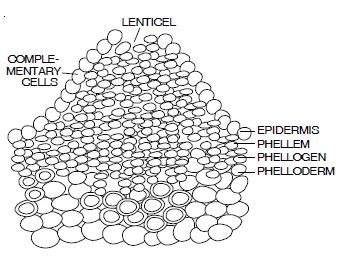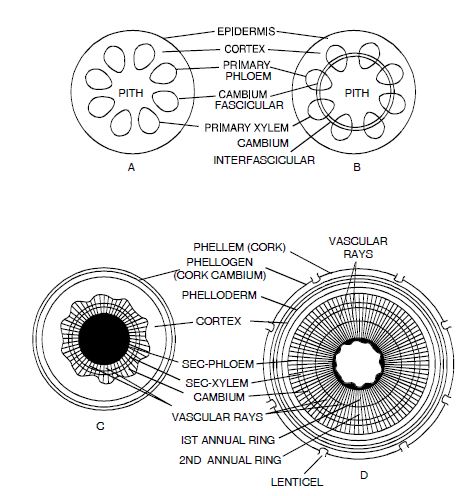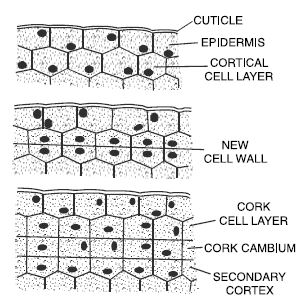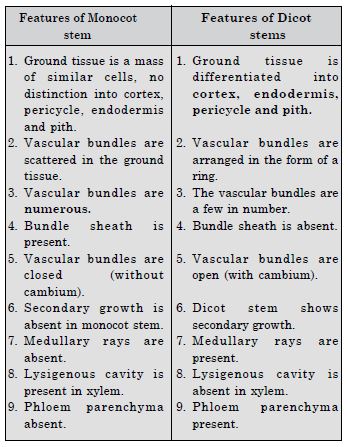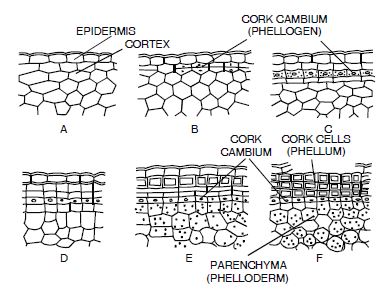Grab access to free NCERT Solutions at Aasoka which are designed by subject matter experts. Keeping the latest CBSE syllabus in mind, these experts have drafted the solutions and ensured to include crucial topics. The NCERT Solutions for Class 11 serves as excellent study material to kick-start your exam preparation. Overall performance and time management can be improved by practicing these questions. Start your preparation now.
The chapter “Anatomy of Flowering Plants” of Biology Class 11 includes a detailed explanation of the anatomy of Monocotyledonous and Dicotyledonous plants, the tissues, functional organization of higher plants, the tissue system, and so much more.
Question 1:
State the location and function of different types of meristems.
Answer:
Meristem. A meristematic tissue or a meristem consists of a group of cells which have the power of active cell division. These cells are living, thin walled and retain the power of cell division. The word meristem has its origin from the Greek word ‘meristos’ which means divisible.
Types of meristem. According to location in the plant body, meristems are of three types :
(a) Apical meristem (b) Lateral meristem (c) Intercalary meristem.
Question 2:
Cork cambium forms tissues that form the cork. Do you agree with this statement ? Explain.
Answer:
Cork. The peripheral water proof tissue of mature woody stem is called cork. It is composed of dead cells with thick walls impregnated with a waxy material called suberin.
Cork is formed by cork cambium (phellogen), a lateral meristem which replaces the epidermis in stems and roots of older woody plants. Thus it is true that cork cambium forms cork.
Cork formation
Question 3:
Explain the process of secondary growth in a stem of woody angiosperm with the help of schematic diagram. What is its significance ?
Answer:
Secondary growth. Secondary growth can be defined as an increase in diameter of the stem due to the activity of the lateral meristems i.e. vascular cambium and cork cambium (Figs. 6.3 and 6.4). The process of secondary growth in a dicot stem can be studied under headings given below :
- Activity of Vascular Cambium. The active vascular cambium forms a ring. This ring is formed by fascicular cambium and interfascicular cambium. Vascular cambium exhibits two types of cell divisions namely additive and multiplicative. Additive divisions result in the formation of secondary phloem towards outside and secondary xylem towards inner side. The cambium has two types of cells. (i) Fusiform initials which are elongated and produce fibres, sieve cells, sieve tubes, tracheids and other vascular elements. (ii) Ray initials which produce parenchyma cells of the rays in wood and phloem.
The secondary phloem is made up of vertical rows of sieve tubes, companion cells, fibres and phloem parenchyma. The horizontal rows of growth in the phloem form, the phloem rays. The phloem rays may be one cell thick or many layered thick. In the secondary phloem, the phloem sclerenchyma is formed and is known as bast fibres and this gives rise to textile fibres of jute, flax and hump etc. The phloem rays translocate the food to the cambium, xylem and other inner living cells.
Diagrams showing stages of secondary growth in Dicot stem The secondary xylem is the main wood of the plant. The secondary xylem consists of vertical rows of tracheids, vessel, xylem parenchyma and xylem fibres. Inbetween radial rows of xylem rays are produced. These rays resemble the phloem ray in structure but transport water and minerals from xylem to the cambium and phloem. Vessels in the secondary xylem are of pitted type and give mechanical support.
Annual rings. The activity of the cambium varies due to the seasonal changes. During favourable conditions i.e. spring the cambium produces the secondary xylem (wood) and is called the spring wood. In the autumn the activity of cambium is less and produces wood of smaller diameter and is called autumn wood. These layers form the rings. The growth rings of spring wood and autumn wood constitute the annual ring. - Acitivity of Cork Cambium. Cork cambium or phellogen develops in the cortex. Cork cambium cuts off cells towards outside which form cork tissue to phellem and towards inner side tissue called phelloderm. Phellem, phellogen and phelloderm, these three together form periderm. Lenticel (pore) appears in the periderm of woody stem. It is packed
with loose aggregate cells called comple-mentary cells derived from the periderm and acts as an organ of gaseous exchange.
A portion of dicot stem showing formation of cork or periderm
Question 4:
Cut a transverse section of young stem of a plant from your school garden and observe it under the microscope. How would you ascertain whether it is a monocot stem or a dicot stem ? Give reasons.
Answer:
The following features are helpful in ascertaining its type :
Based upon the observable features under the microscope, one can easily ascertain whether it is a monocot stem or a dicot stem.
Question 5:
The transverse section of a plant material shows the following anatomical features :
(a) the vascular bundles are conjoint, scattered and surrounded by a sclerenchyma- tous bundle sheaths. (b) phloem parenchyma is absent. What will you identify it as ?
Answer:
The plant material in question is monocot stem.
Question 6:
Why are xylem and phloem called complex tissues ?
Answer:
Both xylem and phloem are made up of more than one type of cells and are, therefore, called complex tissues.
Xylem. It is a permanent complex conducting tissue. It is concerned with upward conduction of water and minerals. It is a group of cells which are similar in origin and function but of more than one type in structure.
Elements of xylem.
Xylem is composed of following four different kinds of elements :
- Tracheids
- Vessel members
- Xylem parenchyma (wood parenchyma)
- Xylem fibres (wood fibres).
Phloem. It is a permanent complex tissue. It is meant for translocation of food materials. Phloem occurs throughout the plant body along with xylem.
Phloem is made up four types of cells :
(1) Sieve tubes (2) Companion cells
(3) Phloem parenchyma (4) Phloem fibres.
Question 7:
What is stomatal apparatus ? Explain the structure of stomata with labelled diagrams.
Answer:
The stomatal aperture, guard cells and the surrounding subsidiary cells are together called stomatal apparatus. Stomata are structures present in the epidermis of leaves. Stomata regulate the process of transpiration and gaseous exchange. Each stoma is composed of two bean-shaped cells known as guard cells. In grasses, the guard cells are dumb-bell shaped. The outer walls of guard cells (away from the stomatal pore) are thin and the inner walls (towards the stomatal pore) are highly thickened. The guard cells possess chloroplasts and regulate the opening and closing of stomata. Sometimes, a few epidermal cells, in the vicinity of the guard cells become specialised in their shape and size and are known as subsidiary cells (Fig. 6.21).
Stomatal apparatus (a) stomata with bean-shaped guard cells (b) stomata with dumb-bell shaped guard cell.
Question 8:
Name the three basic tissue systems in the flowering plants. Give the tissue names under each system.
Answer:
The three basic tissue systems in the flowering plants along with their respective tissue names are :
- Epidermal tissue system com-prising the epidermal cells, stomata and the epidermal appendages-the trichomes and hairs.
- Ground tissue system comprising simple tissues such as parenchyma, collenchyma and sclerenchyma.
- Vascular tissue system consisting of complex tissues i.e. the phloem and the xylem.
Question 9:
How is the study of plant anatomy useful to us ?
Answer:
Value of study of plant anatomy
- It enriches our knowledge of plant structure.
- Anatomical studies can solve many taxonomic problems.
- It helps in determining adulteration in spices, coffee, tea, saffron, Asafoetida (hing).
- The pharmacognosy and pharma-cology are dependant upon the anatomical studies to know about the drug yielding plants and their actions.
- The study of anatomy of wood help in differentiating the type of wood used in preparing various articles.
- Forensic experts require the knowledge of plant anatomy to identify small piece of plants or their products for solving criminal cases.
Question 10:
What is periderm ? How does periderm formation take place in the dicot stems ?
Answer:
As the secondary growth continues for several years, the stem constantly grows in thickness due to increase in secondary vascular tissues. This increase may result in cracking and breaking of outer tissues. To avoid such a breaking of external tissues, the plants develop a new cambium ring, called cork cambium (phellogen) in the outer region.
The cork cambium (phellogen) is a secondary lateral meristem which develops from permanent tissues in the region of epidermis, hypodermis, cortex or even in outer layers of phloem. It produces dead cells or cork (phellem) towards outer side and living cells of secondary cortex (phelloderm) towards inner side. These layers of cork, cork cambium and secondary cortex constitute the protective covering called periderm. The cork cells are highly lignified and check the loss of water from the general surface of stem. Sometimes the layers of cork are interrupted by lenticels.
Question 11:
How does the structure and location of bulliform cells help in performing their specialised function ?
Answer:
Bulliform cells are adaxial epidermal cells along the veins of isobilateral leaf in grasses. These are large, empty, colourless cells. On absorption of water, they become turgid and expose the leaf surface. Due to loss of water, they turn flaccid and make the leaves curl inwards in order to minimise water loss.

